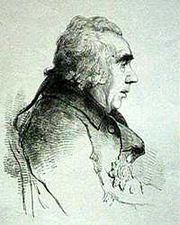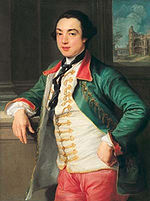
James Caulfeild, 1st Earl of Charlemont
Encyclopedia

Privy Council of Ireland
The Privy Council of Ireland was an institution of the Kingdom of Ireland until 31 December 1800 and of the United Kingdom of Great Britain and Ireland 1801-1922...
(18 August 1728 – 4 August 1799) was an Irish
Ireland
Ireland is an island to the northwest of continental Europe. It is the third-largest island in Europe and the twentieth-largest island on Earth...
statesman
Statesman
A statesman is usually a politician or other notable public figure who has had a long and respected career in politics or government at the national and international level. As a term of respect, it is usually left to supporters or commentators to use the term...
.
The son of the 3rd Viscount Charlemont, he was born in Dublin, and succeeded his father as 4th Viscount in 1734. The title of Charlemont descended from Sir Toby Caulfeild (1565–1627) of Oxfordshire
Oxfordshire
Oxfordshire is a county in the South East region of England, bordering on Warwickshire and Northamptonshire , Buckinghamshire , Berkshire , Wiltshire and Gloucestershire ....
, England, who was given lands in Ireland, and created Baron Charlemont (the name of a fort on the Blackwater), for his services to King James I
James I of England
James VI and I was King of Scots as James VI from 24 July 1567 and King of England and Ireland as James I from the union of the English and Scottish crowns on 24 March 1603...
in 1620. The 1st Viscount was the 5th Baron (d. 1671), who was advanced by Charles II
Charles II of England
Charles II was monarch of the three kingdoms of England, Scotland, and Ireland.Charles II's father, King Charles I, was executed at Whitehall on 30 January 1649, at the climax of the English Civil War...
.
Lord Charlemont was well-known for his love of Classical art and culture and spent nine years on the Grand Tour in Italy
Italy
Italy , officially the Italian Republic languages]] under the European Charter for Regional or Minority Languages. In each of these, Italy's official name is as follows:;;;;;;;;), is a unitary parliamentary republic in South-Central Europe. To the north it borders France, Switzerland, Austria and...
, Greece
Greece
Greece , officially the Hellenic Republic , and historically Hellas or the Republic of Greece in English, is a country in southeastern Europe....
, Turkey
Turkey
Turkey , known officially as the Republic of Turkey , is a Eurasian country located in Western Asia and in East Thrace in Southeastern Europe...
and Egypt
Egypt
Egypt , officially the Arab Republic of Egypt, Arabic: , is a country mainly in North Africa, with the Sinai Peninsula forming a land bridge in Southwest Asia. Egypt is thus a transcontinental country, and a major power in Africa, the Mediterranean Basin, the Middle East and the Muslim world...
. He returned to Dublin and employed the Scottish architect Sir William Chambers
William Chambers (architect)
Sir William Chambers was a Scottish architect, born in Gothenburg, Sweden, where his father was a merchant. Between 1740 and 1749 he was employed by the Swedish East India Company making several voyages to China where he studied Chinese architecture and decoration.Returning to Europe, he studied...
to remodel his main residence Marino House, to design his town house Charlemont House
Charlemont House
Charlemont House was finished in 1763 and designed by William Chambers for James Caulfeild, the 1st Earl of Charlemont. It is a handsome brick fronted mansion on Dublin's Parnell Square. It was bought by the government in 1870 and since 1933 it has housed the Hugh Lane Dublin City Gallery.-External...
and the unique Neo-Classical
Neoclassical architecture
Neoclassical architecture was an architectural style produced by the neoclassical movement that began in the mid-18th century, manifested both in its details as a reaction against the Rococo style of naturalistic ornament, and in its architectural formulas as an outgrowth of some classicizing...
garden pavilion building, the Casino at Marino
Casino at Marino
The Casino at Marino, located in Marino, Dublin, Ireland was designed by Scottish architect Sir William Chambers for James Caulfeild, the 1st Earl of Charlemont, starting in the late 1750s and finishing around 1775. It is a small and perfect example of Neo-Classical architecture, situated in the...
.

Henry Flood
Henry Flood , Irish statesman, son of Warden Flood, Lord Chief Justice of the King's Bench for Ireland, was educated at Trinity College, Dublin, and afterwards at Christ Church, Oxford, where he became proficient in the classics...
and Henry Grattan
Henry Grattan
Henry Grattan was an Irish politician and member of the Irish House of Commons and a campaigner for legislative freedom for the Irish Parliament in the late 18th century. He opposed the Act of Union 1800 that merged the Kingdoms of Ireland and Great Britain.-Early life:Grattan was born at...
; he was a cultivated man with literary and artistic tastes, and both in Dublin and in London he had considerable social influence. He was the first President of the Royal Irish Academy
Royal Irish Academy
The Royal Irish Academy , based in Dublin, is an all-Ireland, independent, academic body that promotes study and excellence in the sciences, humanities and social sciences. It is one of Ireland's premier learned societies and cultural institutions and currently has around 420 Members, elected in...
and was a member of the Royal Dublin Society
Royal Dublin Society
The Royal Dublin Society was founded on 25 June 1731 to "to promote and develop agriculture, arts, industry, and science in Ireland". The RDS is synonymous with its main premises in Ballsbridge in Dublin, Ireland...
. For various early services in Ireland he was made an Earl in 1763, and was in 1783 made a founding Knight of the Order of St Patrick, but he disregarded court favours and cordially joined Grattan in 1780 in the assertion of Irish independence.
He was president of the volunteer convention in Dublin in November 1783, having taken a leading part in the formation of the Irish Volunteers
Irish Volunteers (18th century)
The Irish Volunteers were a militia in late 18th century Ireland. The Volunteers were founded in Belfast in 1778 to defend Ireland from the threat of foreign invasion when regular British soldiers were withdrawn from Ireland to fight across the globe during the American War of Independence...
; and he was a strong opponent of the proposals for the Union
Act of Union 1800
The Acts of Union 1800 describe two complementary Acts, namely:* the Union with Ireland Act 1800 , an Act of the Parliament of Great Britain, and...
. His eldest son, who succeeded him, was subsequently (1837) created an English Baron.
His Life, by F. Hardy, appeared in 1810.

